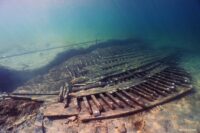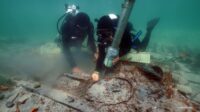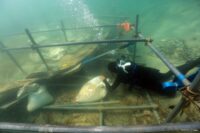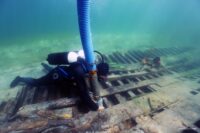 A shipwreck that sank off the coast of Marausa, Sicily, in the late 3rd century has been recovered from the seabed intact. This is the first time a Roman ship has received the painstaking, challenging treatment required to raise a historic shipwreck as it lies, rather than timber by timber.
A shipwreck that sank off the coast of Marausa, Sicily, in the late 3rd century has been recovered from the seabed intact. This is the first time a Roman ship has received the painstaking, challenging treatment required to raise a historic shipwreck as it lies, rather than timber by timber.
Discovered in July 2020 just 300 feet from the shore at a depth of less than six feet, the ship was dubbed Marausa 2 because it is very similar to a wreck from the same period discovered a third of a mile away in 1999. That wreck and its cargo of stoppered amphorae containing dried fruit was recovered in 2011 and was exhibited at the Museo Archeologico Baglio Anselmi in Marsala.
 The Marausa 2 ship is in excellent condition, even better than its namesake. The surviving ship is about 40 feet long and 13 feet wide. A great number of transport amphorae were found lining the hull, most of them broken. Inside the fragmented vessels archaeologists found artifacts of such rarity and high quality that they’re calling them unique in the world. They aren’t saying yet what these unique objects are, however, which is rather wicked of them to tease.
The Marausa 2 ship is in excellent condition, even better than its namesake. The surviving ship is about 40 feet long and 13 feet wide. A great number of transport amphorae were found lining the hull, most of them broken. Inside the fragmented vessels archaeologists found artifacts of such rarity and high quality that they’re calling them unique in the world. They aren’t saying yet what these unique objects are, however, which is rather wicked of them to tease.
The condition of the timbers made it possible for the entire ship to be raised whole. The recovery works began this June, overseen by the Superintendency of the Sea for the region of Sicily. First underwater archaeologists documented and excavated the site. Then they removed all the loose materials and cargo. They used vacuuming equipment to clear as much sediment as possible.
 Engineers created a custom metal structure built on-site to secure the wreck. The underside and top of the ship were secured with nets and fabric sheets and then the whole wreck was encased in the grid to prevent any loss of archaeological material. The entire apparatus was then raised gradually and gently with large flotation devices.
Engineers created a custom metal structure built on-site to secure the wreck. The underside and top of the ship were secured with nets and fabric sheets and then the whole wreck was encased in the grid to prevent any loss of archaeological material. The entire apparatus was then raised gradually and gently with large flotation devices.
The wrapped and caged wreck was then tugged by modern ships 20 miles or so along the coast to the port of Marsala where it spent the night of October 3rd on the pier. The next day it was transported by road to the Museo Archeologico Baglio Anselmi where it was immersed in a fresh water pool. Once the process of desalination is complete and the wood stabilized, it will be moved the museum’s laboratory for consolidation and restoration.
 The restoration will take place in public view. It will take years to complete. Once it is ready for permanent display, it will be placed together with its cargo in a museum space designed to accommodate it somewhere in the province of Trapani.
The restoration will take place in public view. It will take years to complete. Once it is ready for permanent display, it will be placed together with its cargo in a museum space designed to accommodate it somewhere in the province of Trapani.
This video from the Superintendency of the Sea shows the wreck site in all its glory, the surviving timbers, the thick layers of amphorae, how every one the artifacts recovered were labeled by hand, the vacuuming of the sand and the emergence of the hull as the cargo was removed.
Absolutely astounding!!! It’s amazing what’s beneath the hidden waters.